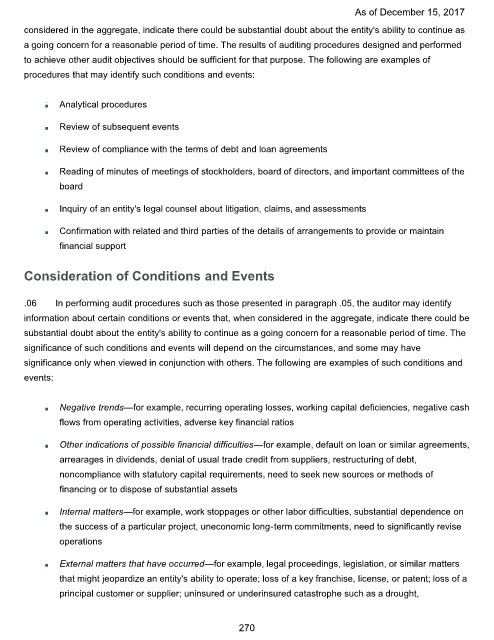Page 273 - Auditing Standards
P. 273
As of December 15, 2017
considered in the aggregate, indicate there could be substantial doubt about the entity's ability to continue as
a going concern for a reasonable period of time. The results of auditing procedures designed and performed
to achieve other audit objectives should be sufficient for that purpose. The following are examples of
procedures that may identify such conditions and events:
Analytical procedures
Review of subsequent events
Review of compliance with the terms of debt and loan agreements
Reading of minutes of meetings of stockholders, board of directors, and important committees of the
board
Inquiry of an entity's legal counsel about litigation, claims, and assessments
Confirmation with related and third parties of the details of arrangements to provide or maintain
financial support
Consideration of Conditions and Events
.06 In performing audit procedures such as those presented in paragraph .05, the auditor may identify
information about certain conditions or events that, when considered in the aggregate, indicate there could be
substantial doubt about the entity's ability to continue as a going concern for a reasonable period of time. The
significance of such conditions and events will depend on the circumstances, and some may have
significance only when viewed in conjunction with others. The following are examples of such conditions and
events:
Negative trends—for example, recurring operating losses, working capital deficiencies, negative cash
flows from operating activities, adverse key financial ratios
Other indications of possible financial difficulties—for example, default on loan or similar agreements,
arrearages in dividends, denial of usual trade credit from suppliers, restructuring of debt,
noncompliance with statutory capital requirements, need to seek new sources or methods of
financing or to dispose of substantial assets
Internal matters—for example, work stoppages or other labor difficulties, substantial dependence on
the success of a particular project, uneconomic long-term commitments, need to significantly revise
operations
External matters that have occurred—for example, legal proceedings, legislation, or similar matters
that might jeopardize an entity's ability to operate; loss of a key franchise, license, or patent; loss of a
principal customer or supplier; uninsured or underinsured catastrophe such as a drought,
270

